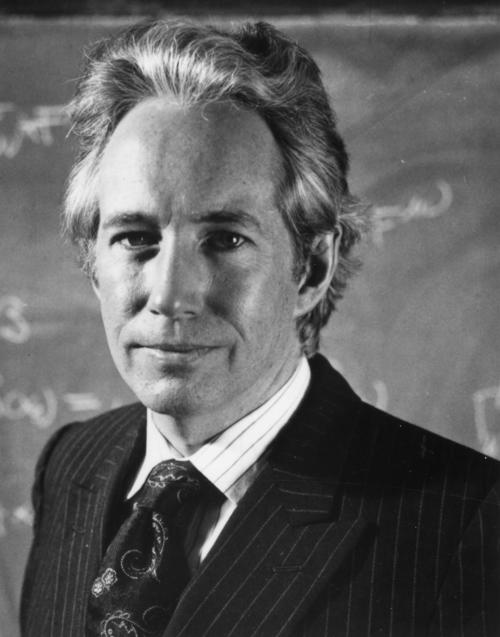IN MEMORIAM
Heinz Pagels

This memorial obituary was originally published by The New York Times (1988) here.
Dr. Heinz R. Pagels, a physicist and popularizer of science and executive director of the New York Academy of Sciences, died Sunday in Colorado in a mountaineering accident. He was 49 years old.
Dr. Pagels, the author of several books that seek to explain to the public the more strange and difficult aspects of modern physics and cosmology, was attending the summer session of the Aspen Center for Physics. During the weekend break he and Dr. Seth Lloyd, his former student at Rockefeller University, climbed Pyramid Peak, a 14,000-foot summit 10 miles to the southeast.
Dr. Pagels, a tall, slender man, stepped on a rock that proved unsteady and lost his balance. He fell and slid down a steep slope. His body was discovered at the foot of a deep gorge after a helicopter search.
In reviewing Dr. Pagels’s 1985 book ”Perfect Symmetry,” Dr. David N. Schramm, a cosmologist at the University of Chicago, said, ”Heinz Pagels is one of less than a handful of active scientists who can write excellent prose about the scientific frontier for a general audience.”
He described an earlier book by Dr. Pagels, ”The Cosmic Code,” published in 1982, as ”a beautiful account of modern physics, of the quantum-mechanical world of particles and their interactions.” Dr. Pagels had also contributed articles to The New York Times on cosmology and other subjects.
His most recent book, published by Simon & Schuster, is entitled ”The Dreams of Reason – The Computer and the Rise of the Sciences of Complexity.” A discussion of complexity by Dr. Pagels and Dr. Lloyd, who received his doctorate in June under Dr. Pagels, is featured in the current issue of Scientific American.
Using a measure they called ”thermodynamic depth,” the article seeks to reconcile the puzzling contradictions between the seemingly universal descent into uniformity, known as entropy, and growing complexity as evolution proceeds.
Staying with Dr. Pagels in Aspen was his wife, the former Elaine Heisey (Pagels), a professor of religion at Princeton University and an authority on early Christianity. Her latest book is ”Adam, Eve and the Serpent.”
She said yesterday that while at Aspen, she and her husband went walking almost every Saturday but that she was not on Sunday’s climb.
Heinz Rudolph Pagels was born in New York City on Feb. 19, 1939. He received a Bachelor of Science degree from Princeton University and, in 1965, a doctorate in physics from Stanford University. He joined Rockefeller University the following year, leaving in 1983 as an associate professor to become executive director and chief executive officer of the New York Academy of Sciences.
As president of the International League for Human Rights, Dr. Pagels supported greater freedom for researchers in other countries. He was a fellow of the New York Institute of the Humanities at New York University, a member of the Council on Foreign Relations, a member of the Science and Law Committee of the New York Bar Association and a trustee of the New York Hall of Science.
Dr. Pagels ended his book ”The Cosmic Code” with reflections on the dangers of mountain climbing and why the sport appealed to him. He wrote that ”the rewards I wanted were of sight, of pleasure, of the thrill of pitting my body and my skills against nature.”
Like many climbers, he wrote, he often dreamed about falling. ”Lately I dreamed I was clutching at the face of a rock but it would not hold,” he wrote. ”Gravel gave way. I grasped for a shrub, but it pulled loose, and in cold terror I fell into the abyss.”
But in the dream, he wrote, he then realized that ”what I embody, the principle of life, cannot be destroyed.” He continued: ”It is written into the cosmic code, the order of the universe. As I continued to fall in the dark void, embraced by the vault of the heavens, I sang to the beauty of the stars and made my peace with the darkness.”
In a telephone interview yesterday Dr. Lloyd said that on Sunday he and Dr. Pagels had had lunch on the summit of Pyramid Peak, then had started down at 1:30 P.M. Dr. Pagels was in the lead because ”he knew the mountain,” Dr. Lloyd said, having climbed it seven times. It was the first ascent of the peak for Dr. Lloyd.
Dr. Pagels was a ”very careful hiker,” Dr. Lloyd said, avoiding loosening any rocks, since there were many climbers on the mountain.
One scientist at the physics center session, Dr. Jeremy Bernstein, himself an experienced mountaineer, said yesterday that the outing that Dr. Pagels was on was ”closer to a hike than a difficult rock climb,” but ”very dangerous” because of the treacherous nature of the rock.
Besides his wife, Dr. Pagels is survived by a daughter, Sarah, 2, and an adopted son, David, 3 months old. A son Mark, to whom ”The Dreams of Reason” is dedicated, died in April 1987 at the age of 6. Other survivors are Dr. Pagels’s mother, Marie Pagels of Wynwood, Pa., and a brother, Rolf, of Lake Oswego, Ore.
A version of this article appears in print on July 26, 1988, Section B, Page 7 of the National edition of The New York Times with the headline: Dr. Heinz Pagels, 49, a Physicist, Dies in Fall From Colorado Peak.
Read more about Heinz Pagels in Jeremy Bernstein’s history of the Aspen Center for Physics, “The First 35 Years,” here.

Positions Held
Scientific Secretary, 1973 – 1974
Treasurer, 1974 -1979
Trustee, 1972 – 1981